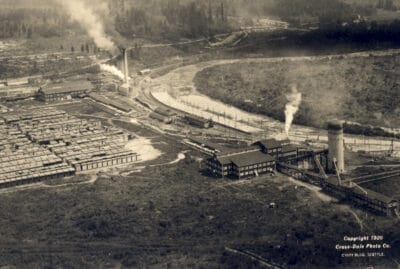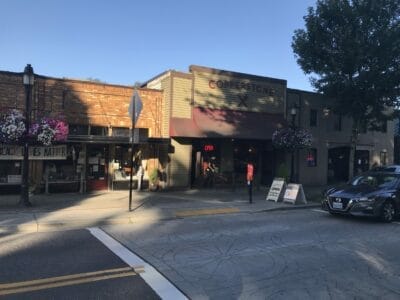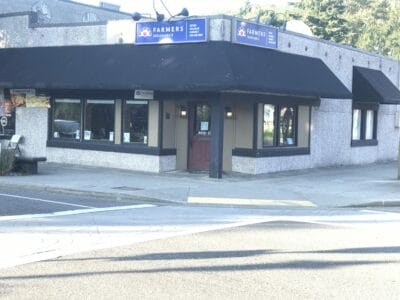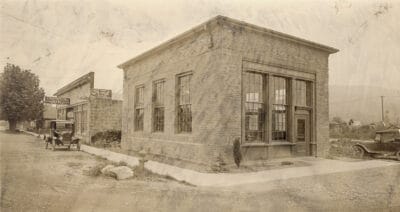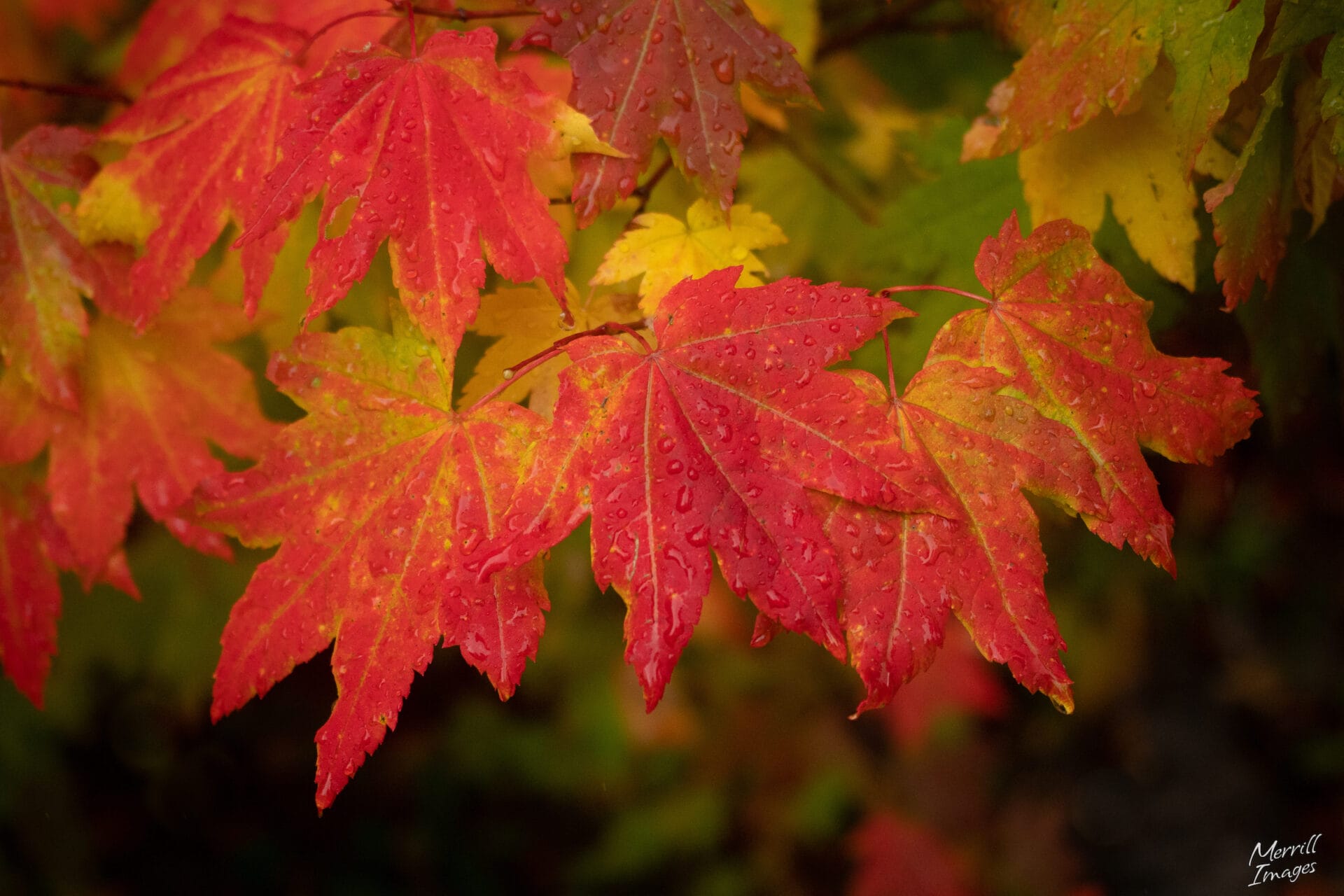Snoqualmie Historic Walking Tour
Look back in time to when logging, farming, and railroads ruled the region as you stroll through historic downtown Snoqualmie. The tour takes you past numerous historic structures including schools, hotels, taverns, and movie theaters. Click on the links to see historic photos and learn more. The 4Culture King County Lodging Tax and the Snoqualmie Lodging Tax Advisory Committee provided generous support for the development of this tour.
[Note all historic photos below courtesy of the Snoqualmie Valley Historical Museum]
Itinerary
-
Railroad Park and Centennial Log Pavillion
Start your day by parking at Railroad Park & Centennial Log Pavilion in downtown Snoqualmie. For a beverage or snack before you start your walk, head across the street to the many fun shops, restaurants, and cafes.
Begin the tour at the Log Pavilion. Built with timbers from Weyerhaeuser’s Snoqualmie lumber mill, this open structure shelters an old-growth Douglas fir log typical of those cut in the early logging days. Check out the interpretive sign to learn more about Snoqualmie’s logging legacy. The Centennial Log made appearances in the cult classic TV show Twin Peaks. You can visit other filming locations on our Twin Peaks tour.
For a side trip head north on Railroad Avenue to the Centennial Trail Exhibit. The Centennial Trail runs alongside the historic railroad and features a train car exhibit. Each historic railcar has its own interpretive sign.
-
Hotel Snoqualmie
From the Centennial Log Pavilion head south and take a right on SE King Street and locate the building at 38600 SE King Street on the right. The building originally housed the Hotel Snoqualmie, built in 1910. Jacob Burton subsequently owned the building and 1940 tax records included a photo of the structure with “Burton Hotel-Apartments-Rooms” painted on the side. A fire in 1960 prompted remodeling, including the loss of the second story.
-
Snoqualmie Grade School
Continue walking west on King Street for a block and a half to Silva Avenue SE. Across the street and to the right you’ll see the original Snoqualmie Grade School, built in 1911. For a period of time, a complex including this building and an adjacent high school building operated as the Snoqualmie School District, serving first through 12th grades. When the Fall City, Snoqualmie and North Bend School Districts merged, the adjacent building housed the initial Mount Si High School from 1946-1952 before completion of the new Mount Si High School building on Meadowbrook Way. The Snoqualmie Grade School building continued to operate as 1st-8th and later K-8th well into the 1960s when Snoqualmie Elementary and Snoqualmie Middle Schools were built. Subsequently it has served as the Snoqualmie Valley School District headquarters.
-
The Woodman
Turn back east along King Street until you get to the bright yellow-orange two story building on the right. Now the third oldest building in Snoqualmie, The Woodman, constructed in 1902, originally housed the Modern Woodman of America fraternal organization. Later that same year the Independent Order of Odd Fellows acquired the building as subsequently did the Fraternal Order of the Eagles. Over the years, many community groups met here including the Veterans of Foreign War and Boy Scouts. The building also hosted the annual Fishing Derby Pancake Breakfast along with many community fundraisers. Later incarnations included an antique store and dance studio before its restoration in the 2000s.
-
Snoqualmie Depot
Just beyond the Woodman sits the oldest building in Snoqualmie – the Snoqualmie Depot. Built in 1890 by the Seattle, Lake Shore and Eastern Railroad, the Depot stimulated much of the original development in town. The promise of transportation and commerce brought settlers, tourists, and business folks to the city. This handsome Queen Anne-style Depot outclassed all the other Valley depots. Find out why in our blog. The Northwest Railway Museum has occupied the Depot since restoring it to its original grandeur in 1981. Open year round, the Museum also offers 2-hour train rides year-round on weekends.
-
Latberger's Barber Shop
Cross the street and head to the two adjacent storefronts occupying 8008 and 8010 Railroad Avenue. This pair of commercial buildings includes a taller, narrower, southern storefront built in 1910 and the lower northern portion built in 1920. Starting with Latberger’s Barber Shop, a barber shop has always occupied one of these two buildings. They have acted as community information centers for over 100 years. Locals frequently visit to hear the latest gossip while they get their ears lowered or get a cup of coffee next door.
-
Glazed Brick Building
Continue walking south past a series of buildings set back from the street. This area originally housed the Nye Brothers General Merchandise store, which sat squarely on Railroad Avenue. Continue a little further to The Black Dog café. Built in 1928, this Glazed Brick Building replaced a small wooden building that housed a cobbler shop and a variety store. It represents a unique example in Snoqualmie of a vernacular interpretation of the 1920s Moderne (or “streamlined modern”) commercial design. The original developer and/or owner has not been identified. Louis A. Wade, who served as a justice in Snoqualmie Falls, purchased the building in 1933. From tax records, it appears that in 1940 the property housed the offices of Valley Insurance and Copass & Hall Lawyers.
-
Bennett Confectionery and Ice Cream Parlor
Copperstone Family Spaghetti Restaurant sits just next door. This building originally housed a cafe and tavern in 1921. During prohibition, the tavern operated as a “soft drink” and pool hall. In 1940 the Bennett Confectionery and Ice Cream Parlor occupied the building.
The Bennett Confectionery appears on the right in the historic photo below.
-
Sunset Theatre
Take a few steps further next door to Sigillo Cellars. This two-story stucco-clad building was constructed in 1919 as a movie theater, most likely for E.W. Sandel. Sandel operated theaters in North Bend and Issaquah in addition to working as a druggist in Snoqualmie from 1917-1922. He operated the theater as the Dream Theater until about 1923, when William Cochrane acquired it. Cochrane, who had just built the Brook Theater in Meadowbrook, changed the Dream Theater’s name to the Sunset Theatre. The new name referenced the building’s location on the Sunset Highway (Railroad Avenue).
The main entry is recessed beneath a low, arched opening framed by a larger rectangle. The design recalls a proscenium arch on a stage. At the top of the parapet, a prominent cornice with rounded coronae projects from the building.
Cochrane closed the Sunset Theatre in January 1930 in response to declining ticket sales and the public’s desire for movies with sound not accommodated in the theater’s design. A 1939 remodel readied the building for a new purpose – to house the town hall and the fire station. During World War II it supported the local air raid tower and horn. In 1946, Snoqualmie established its first library on the upper level.
-
Kritzer's Meat Market
Walk a few steps again next door to Down to Earth Flowers and Gifts. Constructed in 1901, this building for many years housed Kritzer’s Meat Market , operated by Joseph and Mary Kritzer. The date they began operating in this building is uncertain. They first advertised in the 1907/08 Gazetteer as a butcher; and may have moved to this building immediately after its construction. They definitely operated at this location in the 1920s, and continued into the 1940s. Long-time owner Mena K. Mahoney sold the building to Victor Klement in 1962. Klement remodeled the building for use as a jeweler’s shop and added the agate inlay found in the bulkhead below the shop windows.
-
The Fury Block
Advance immediately next door again to a one-story brick commercial structure containing three separate shop spaces. William Fury built this structure in 1928. Referred to as The Fury Block, it was the most substantial commercial development in the historic district in the late 1920s. Before construction of the Fury Block, the Fury & Kinsey Livery stable occupied this site, and the Livery was converted to a garage in the 1920s.
-
Kinsey Hotel Complex
At the end of the block, on the corner of Railroad Avenue and River Street, sits a one-story rectangular commercial structure built in 1920 and enlarged to the north in 1926. The Kinsey Hotel Complex occupied this site at the turn of the century, and burned in 1902. The Kinsey Hotel Complex had three stories with five dormer windows across the front on the top floor. A post office and meat market occupied space on the lower floor and a dance hall occupied space on the second floor.
The parents of future famous logging photographers Darius and Clark Kinsey operated the complex with the help of their five sons and one daughter. While operating the hotel, a guest taught all the boys photography.
-
Snoqualmie Methodist Church
Head across Railroad Avenue to the Snoqualmie Methodist Church. The first services were actually held under a maple tree on the river. Church members fixed the probable date of that first Snoqualmie sermon as Sept. 24, 1889. The original church building can be seen across the street. It is now the American Legion Hall and was built in 1892 by Edmond Kinsey who ran the Kinsey Hotel Complex across the street. The current church, built in 1924, caught fire in In 1939 prompting the Snoqualmie Fire Department to get its first fire engine in 1940. Previously the Department only had a human pulled pump cart and hose cart to fight fires. Read more about the history of the church here.
-
State Bank of Snoqualmie
Head back across Railroad Avenue on River Street, and on the right you’ll find a handsome brick building, currently occupied by Buckshot Honey Restaurant. Originally built in 1923 as the State Bank of Snoqualmie, it has served many purposes over the years. In addition to being a bank, the building also housed Snoqualmie City Hall, office space, and the Snoqualmie Valley Chamber of Commerce and Visitor Center.
In November 1990, when the building was City Hall, it was hit hard by flooding. This forced the city office to relocate temporarily to North Bend. It wasn’t until two years later that they were able to move back in. Read more about its history here.
-
Reinig Brothers General Merchandise
Across the street, you’ll see Carmichael’s Hardware and Variety store. This large wood-frame commercial building was built as Reinig Brothers General Merchandise in 1909, Otto Frank Reinig, Proprietor. It replaced a 1902 building on the same site which had been destroyed in 1908 by a fire that had originated in a hotel across River Street.
This building is the only remaining building in Snoqualmie significantly associated with Otto Reinig, a prominent Snoqualmie citizen in the early 1900s. Otto was the son of influential early Snoqualmie residents Leonard and Margarethe Reinig. He started in the grocery business in the early 1900s after spending five years in Dawson during the Klondike gold rush. Read more about the building’s history here.
-
The Snoqualmie Post
On the northeast corner of the same intersection sits the Snoqualmie Post building. Built in the 1910s, this building has served as the home of Snoqualmie’s newspaper for over a hundred years, first housing the Snoqualmie Post and then later the Snoqualmie Valley Record. Prior to operating out of this building, the paper operated out of a hotel across the street and the original printing press was daringly rescued from that building when it burnt down.
From 1949 to 1961, Charlotte Paul Groshell and her husband Ed Groshell operated the newspaper, during which time Charlotte wrote several best-selling books about her life operating the newspaper and fictions about life in the Valley during the pioneer era. Her first novel appeared in 1950—Hear My Heart Speak, about a World War I veteran, psychologically damaged from the war, living in a rural Wisconsin community. Stories heard from old-timers of the Snoqualmie Valley provided a rich source of lore for two historical romances, the bestselling Gold Mountain (1953) and The Cup of Strength (1958), later republished as Wild Valley (1981). Her own family’s pursuit of independence was memorialized in Charlotte’s only two nonfiction books, the bestselling Minding Our Own Business (1955) and its sequel, And Four to Grow (1961).
Since 1961, the Snoqualmie Valley Record has been operated by several owners and currently is run by Sound Publishing.


